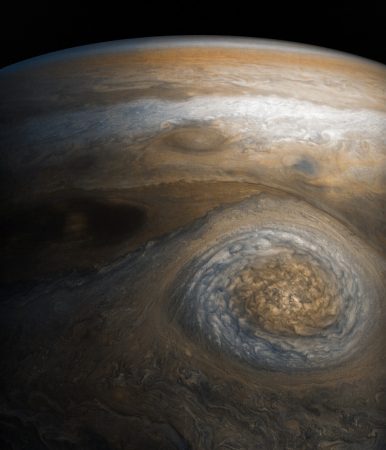On Jupiter, polar cyclones shaped like sawblades and spirals swirl and lightning flashes above a deep and essentially bottomless atmosphere. Meanwhile, about 500 million miles away in Houghton, Michigan, six inches of lake effect snow falls with barely a predicting blip on the radar. Shawn Brueshaber wants to learn more about both of these intriguing phenomena, and if they have more in common than we think.
One wouldn’t expect to find a planetary atmospheric scientist in an engineering department, but Brueshaber holds a bachelor’s degree in aerospace engineering and earned his master’s and doctoral degrees in mechanical engineering. He draws on his engineering background every day.
From a mechanical and aerospace engineering perspective, it’s all fluid mechanics, says Brueshaber. “The only difference is we’re not playing around in, say, a jet turbine. We’re studying fluid mechanics on a rotating spherical body over a very large scale—in the thousands and thousands of kilometers.”
Brueshaber’s Planetary Atmospheric Works (PAWs) lab studies everything from lake effect snow to the atmospheric dynamics of the solar system’s giant planets. Current PAWs work includes prototyping an inexpensive radiosonde design (battery-powered instruments that measure temperature, pressure, humidity, wind speed, and direction) from biodegradable containers. Attached to a weather balloon, radiosondes monitor the size and composition of airborne particulates to help researchers learn more about local air quality.
Using high-powered computers, the PAWs lab runs simulations of weather patterns on Earth Uranus, and Neptune. The lab also processes images from NASA’s Juno space probe orbiting Jupiter.
A Happy Accident: Juno and the Role of Citizen Scientists
Juno has orbited Jupiter since 2016, circling from pole to pole rather than around its equator like previous spacecraft. Its primary mission is to measure Jupiter’s composition, gravitational field, magnetic field, and polar magnetosphere. It also searches for clues about how the planet formed, including whether it has a rocky core, the amount of water present within the deep atmosphere, mass distribution, and its deep winds.
Included on the probe is JunoCam, NASA’s first-ever camera dedicated for public outreach. Photos are posted to the JunoCam website for researchers and space enthusiasts to review. JunoCam’s scientific relevance quickly increased when the first images came in.

“The first images we got showed these circumpolar cyclones, and we were all agog,” says Brueshaber. Cyclones circle each pole, with the northern cluster’s cyclones ranging over 2,500 miles wide—about the size of the continental United States.
Each pass from Juno gives new information: the cyclones often arrange themselves into an evenly-spaced polygon formation. They’re low-pressure systems and relatively shallow, unlike Jupiter’s famous Great Red Spot, high-pressure system extending some 200-500 km below the visible cloud deck. The polar cyclones stay stable and individual rather than merging together. Lightning isn’t uncommon, Brueshaber says, adding in the fun fact that the planet with the most lightning occurrences is Earth.
JunoCam provides a unique opportunity for amateur space enthusiasts to collaborate with the research community. These citizen scientists have trained artificial intelligence to identify storms, commented on anomalies on the JunoCam website, and even provided their own telescope images to fill in the blanks on planetary activity in between Juno’s flyovers.
Juno’s primary mission was scheduled for 35 orbits, to conclude in 2021. The data from the probe was so enlightening, and Juno itself so durable, that it pivoted to an extended mission. It’s currently on its 70th orbit. NASA hopes to get a second extended mission.
Bringing the Lessons Down to Earth
JunoCam photos are only a portion of the data processed in the PAWs lab. As researchers ranging from undergraduates to faculty members also review data of weather on Earth and run simulations of the atmospheres of Uranus and Neptune, they’re considering the bigger, underlying question: how might we use this data to better understand our weather, our planet, and our universe? Can Jupiter’s polar storms offer any insights that we can use to better understand weather on Earth?
Brueshaber likes to explain the importance of his research with an analogy: Earth is to atmospheric science research as a platypus is to veterinary science.
Like the platypus, Earth is a unique amalgamation of features. With an atmosphere and plate tectonics unlike anywhere else, life has impacted the makeup of our planet since the first single-celled organism wiggled onto the scene.
In the same way that a veterinarian can’t fully understand the full scope of the animal world by exclusively studying platypuses, atmospheric scientists can’t study a single planet as a means to develop comprehensive theories on meteorology and climatology. Lessons learned from other planets have the potential for downstream impacts that will improve our daily lives, such as decoding our own complicated weather systems. Data from the far reaches of the solar system could give us increased time to prepare for severe weather and improve climate modeling. It could offer a better understanding of turbulence to make air travel more comfortable. It could also aid in unleashing the long-sought goal of fusion energy production.
For most folks, “How’s the weather?” is a rather simple conversation-starter. At the PAWs lab, it’s an introduction to a complex field full of fascinating insights.
